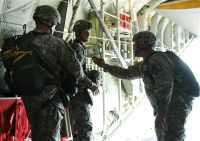FORT BRAGG, N.C. — Army Chief Warrant Officer 2 Michael Sanders, a 43-year-old senior interrogator with the XVIII Airborne Corps here, battled a bad knee to earn the coveted master parachutist wings, the highest-level airborne skills award, other than the combat parachutists badge.
Wearers of these wings are experienced airborne troops that have demonstrated exemplary skills and leadership. The badge is awarded to individuals who’ve conducted 65 jumps from aircraft, graduated from a jumpmaster’s course, and have served on jump status with an airborne unit for a minimum of 36 months.
Jumpmasters manage and lead combat-equipped airborne paratrooper missions involving both training and actual combat operations. Paratroopers who complete airborne jumps into combat zones can wear the appropriate-level combat parachutist badge.
However, prior to becoming a soldier, Sanders did a five-year stint in the Air Force during which time he was stationed in the United Kingdom for three years.
“That was the best time in my life,” Sanders recalled. “I got to play football, visit places like Buckingham Palace, Parliament and the London Bridge. England has a beautiful countryside and I loved seeing all of the history.”
Seeking a new profession within the military, Sanders left the Air Force for the Army Reserve. After his time in the Reserve, Sanders, a fourth-generation military veteran, decided that the Army was a good fit.
“The Army was my choice,” he explained. “I didn’t want to go anywhere else but the Army because my family has a history of serving in the military.”
Sanders served with the 75th Ranger Regiment from 2002 to 2004, during which time he changed his military occupational specialty from mechanic to interrogator.
“What do you have that’s critical?” Sanders recalled asking his Army career counselor. Sanders ended up choosing the military intelligence field and soon after departed for interrogator school.
“Once I got through the school and saw how interrogations were performed, I realized that I enjoyed it,” Sanders said. “Since then, I’ve studied about how to be a better interrogator and how to perfect my craft.”
Sanders returned to Fort Bragg in 2009, when he was presented with another challenge.
“When I first got here, I knew I was going to be back on jump status, but I have a very beat up right knee,” Sanders explained. “The doc has already told me, ‘You’re a 42-year-old person with a 65-year-old’s knee.’ ”
Shortly after arriving back at Fort Bragg, Sanders learned that more jumpmasters were needed to lead airborne training missions.
“They told me, ‘Sir, a lot of soldiers are probably going to be thrown to the wayside because we won’t be able to cover enough planes,’ ” Sanders recalled.
After obtaining authorization to wear a stabilizing knee brace during jumps, Sanders committed to jumpmaster duty again. Sanders’ leadership and work ethic have garnered praise from his superiors.
“He loves the Army, his work and his soldiers,” Chief Warrant Officer 4 John Stocks said of Sanders. “That is never going to stop. He is one of the most motivated soldiers I know.”
Source:
U.S. Department of Defense
Office of the Assistant Secretary of Defense (Public Affairs)

 von
von 